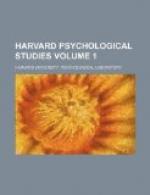Motor impulses played a large part in the process of suppression, such as head and eye movement away from the image to be suppressed, contraction of the muscles of the forehead and scalp, occasional ‘setting’ of the teeth, pressure together of the hands when they were supposed to be holding the image and of the knees under like circumstances. The eye traced outline and details and the more actively it could be so employed the more successful was the suppression. The sensations of accommodation and of focusing previously referred to were repeated in this series. Enunciation also was very common.
Frequent comparison of the image with the percept was made at the close of experiments and showed the utmost diversity in size, vividness and distinctness. During an experiment when the suppressed image came back, it was rarely more than a mere blur of color; in two or three instances the form came without color. Green was found to be a difficult color to hold. C. had an orange after-image from a retained yellow image, a red image having been suppressed. Between the images of a gray disc and an orange disc, three inches apart, he had a blue disc. J., while suppressing an orange disc and retaining a green disc, noticed that ’when off the fovea the whole green disc became bright orange.’ There was always a sense of readiness on the part of the suppressed image to slip back. As C. expressed this, “The thing suppressed exists in the fringe of consciousness.” The recurring image usually came back at its original position even when the retained image was being held in a different part of the field. In such cases the retained image at once resumed its original place.
G. and J. were successful in proportion as they freed themselves from the nervous strain of anxiety as to the result.
V. MOVEMENTS OF A SINGLE IMAGE, THE OBJECT HAVING BEEN MOVED DURING THE EXPOSURE.




